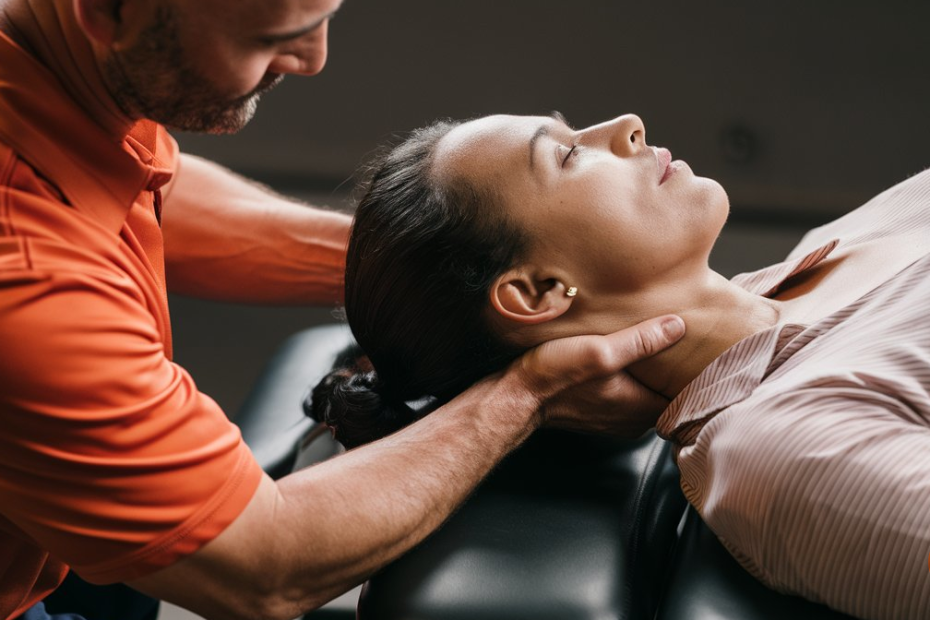The muscles at the back of the neck, found deep to the trapezius, play a crucial role in neck movement and stability. These muscles range from small, diagonal fibers to larger muscles that originate in the upper thoracic spine and attach to the neck or base of the skull. Their primary function is to aid in extending the neck and head, with some muscles also contributing to neck rotation.
When these muscles become overworked, they can cause discomfort, restricted movement, and referred pain. Understanding the symptoms and how to release these muscles effectively can help manage neck pain and prevent recurring issues.
Symptoms of Overworked Neck Muscles
When the muscles in the back of the neck are strained or overworked, they can trigger various symptoms, including:
- Neck pain and stiffness: Overworked muscles limit your range of motion and cause discomfort, often making simple neck movements challenging.
- Headaches: Tension from these muscles can refer pain to the top of the skull or behind the eyes, often leading to tension-type headaches.
- Pain at the base of the skull: The suboccipital muscles are common culprits when it comes to pain near the base of the skull, which may worsen with movement.
- Upper back and shoulder pain: Discomfort can also spread to the upper back and shoulders, especially when the muscles overcompensate for limited mobility in other areas.
- Referred pain: Pain from the diagonal muscles that connect to the skull may radiate along the side of the head or behind the eyes, especially from forward head posture or excessive lifting.
These symptoms often stem from repetitive stress or prolonged positions, such as the head-forward posture common in many activities or from lifting heavy weights while hyperextending the neck.
Causes of Overworked Neck Muscles
Forward head posture, whiplash from motor vehicle accidents, and straining the neck while lifting heavy objects, such as during a deadlift, are some of the key causes of neck muscle overwork. The muscles at the back of the neck often compensate for a hypomobile thoracic spine or upper cervical joint dysfunction. This makes it essential to not only address the posterior neck muscles but also check the muscles at the front of the neck.
Treatment Techniques
There are several ways to treat overworked neck muscles, both in a clinical setting and at home:
- Acupuncture
- Active Release Techniques (A.R.T.)
- Dermal traction (cupping)
- Instrument-assisted soft tissue manipulation (IASTM)
- Self-myofascial release using a ball or similar device
Self Myofascial Release to the Muscles on the Back of the Neck
One of the easiest ways to release these muscles on your own is with a ball or half-ball. Here’s a step-by-step guide:
- Place the ball anywhere along the back of the neck, from the base of the skull to the upper back.
- Apply pressure through the trapezius to access the muscles underneath.
- Once you’ve made contact with the muscle, bring your chin down towards your chest. You’ll feel tension pulling the ball upward.
- Resist this tension by pressing the ball in the opposite direction with your hand.
- For an added stretch, slightly rotate your head left or right, maintaining contact with the ball. Hold the stretch for 30 seconds to a minute, twice a day.
Evidence-Based Benefits of Stretching and Massage
Research shows that stretching and massage techniques like myofascial release can significantly reduce muscle tension, improve range of motion, and alleviate pain. Stretching improves flexibility, enhances blood flow, and helps restore normal muscle length. Massage, including techniques such as A.R.T. and IASTM, helps break down adhesions and scar tissue, promotes tissue healing, and reduces pain sensitivity.
Posture Awareness: Movement Variability is Key
It’s not simply the position of your head or slouching that leads to neck pain—it’s the inability to move out of those positions. Prolonged static postures, whether it’s forward head posture or extended neck positions during heavy lifting, place excessive strain on the neck muscles. This repetitive stress causes them to overwork and become tight.
The key to preventing and managing neck pain lies in movement variability. Incorporating frequent movement changes, taking breaks from static positions, and building flexibility through stretches and exercises is essential for maintaining healthy neck function.
Lifestyle Changes to Reduce Neck Pain
Alongside manual therapies and self-care techniques, making lifestyle changes can have a significant impact on reducing neck pain:
- Incorporate movement breaks: Avoid prolonged static positions, such as sitting at a desk or staring at a screen for too long. Set a timer to remind yourself to move every 30 to 60 minutes.
- Optimize ergonomics: Adjust your work environment to promote better alignment. Raise your computer screen to eye level and ensure your chair supports a natural spinal curve.
- Practice movement variability: Throughout the day, ensure you’re moving in different planes of motion. This keeps muscles from becoming overworked in one position and promotes joint health.
- Strengthen supporting muscles: Focus on exercises that improve the strength and endurance of the neck, shoulders, and thoracic spine. Strengthening these areas can reduce the demand on overworked muscles.
- Manage stress: Chronic stress often manifests as muscle tension, especially in the neck and shoulders. Incorporating stress-reducing practices like yoga, mindfulness, or breathing exercises can help reduce overall muscle tightness.
Take Control of Your Neck Health Today!
Don’t let neck pain slow you down. If you’re experiencing any of the symptoms mentioned or feel like your neck muscles are overworked, now is the time to take action. Implement the self-care techniques outlined here and start making small lifestyle changes to reduce muscle tension and pain.
If you need more personalized guidance or hands-on treatment, schedule an appointment with us today. Together, we’ll create a plan to relieve your pain, improve your mobility, and keep you moving freely. Your neck—and your whole body—deserve it!
Originally posted on May 17, 2022 @ 4:39 pm
